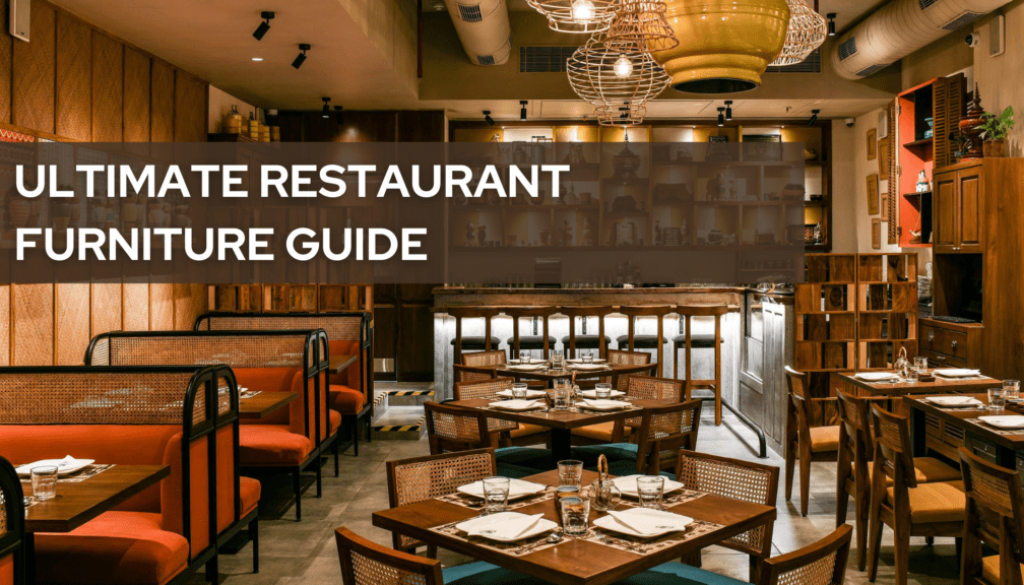Restaurant Furniture Guide
This restaurant furniture guide will help you understand that furniture is more than just a place for guests to dine; it can remind them of your brand identity, set the tone for an establishment, and influence the overall ambience. Picking the ideal furniture requires more than aesthetic judgement; it’s an act of balance between style, comfort, durability, and functionality. This all-inclusive guide will assist you in sailing through the complexities of choosing just the right restaurant furniture to make your space both stunningly beautiful and functionally practical.
Consider These Points Before Finalising Your Restaurant Furniture: A Restaurant Furniture Guide
Before one even begins to consider the selection process, some key variables will definitely impact your furniture choices: the type of dining experience you wish to provide, space, budget, and durability of materials. Proper consideration of these factors creates informed decisions that assure better customer experiences, improved use of space, and closer alignment to financial and operational objectives.

1. Define the Style and Theme of Your Restaurant
Defining the style and theme is actually the critical determinant in coming up with the right furniture for your restaurant. This may take into consideration creating a specific atmosphere, anything from a cosy, rustic type of café to a modern, minimalist-type bistro or an exquisite fine dining restaurant. The furniture should be both practical and visually pleasing to bring out the idea of your restaurant. For instance, a restaurant with a beach theme would incorporate pale wood or wicker furniture with accents of blue and white to portray an airy feel by the sea. A city café, on the other hand, would be more trendy, using industrial metal chairs and wooden tables made from reclaimed wood to provide a modern feel.
It should concur with other interior aspects, such as lighting, decoration, and wall colour. You also have to keep in mind what kind of clients you want to accommodate; for instance, families need comfortable and robust seating offering space, while the young, trendy audience will require a sleek, stylish design.
2. Choosing Tables
Tables are the backbone of seating in your restaurant and can also be the star of the show when it comes to dining. You’ll want to pick your tables for style, but you should also think about functionality. The size and shape of your tables should reflect the space and type of dining you see yourself serving. Example:
- Round Tables: The best for small, intimate groups and dining, since everybody is central; this helps in stimulating conversations. They also contribute to a more open flow in smaller spaces.
- Rectangular Tables: Best for larger groups, maximising seating capability in linear spaces. They can be more versatile when pushed together in dealing with even bigger parties.
- Square Tables: Because they can easily be rearranged into different sets, they are pretty flexible. These include sets for two, four, or more.
Another significant factor is material selection. Solid-wood tables are classic, solid choices that can work for everything from rustic to modern. Tables made of metal or glass are pretty contemporary and easy to clean; hence, they are perfect for casual dining. Give a close look at the height of your table, too, because this will already predetermine the comfort of your guests, along with how nice your chairs will look.
3. Selection of Chairs
The chairs should balance between comfort and style. A great chair can make the dining experience, while a bad one can break it. Here is a look at some considerations to be made while selecting your chairs:
- Comfort: The chairs should provide a lot of support, especially if your customers are likely going to be in them for an extended period. For fine dining places, padded or upholstered chairs are vital in ensuring comfort, but simple designs may be acceptable for quick-service restaurants.
- Design: The design of the chair should rhyme with that of the tables and be in line with the concept of your restaurant. For instance, high-backed chairs take command of the stylish air, while ordinary wood stools would be suitable for the restaurant that is supposed to wear a casual and relaxed outlook.
- Practicality: Consider the functionality of the chairs. Stackable chairs are very convenient if you have to store them away or even rearrange them often, while chairs with armrests could be more comfortable but take up more space, which is a significant concern in smaller dining rooms.
- Materials: The material for the chair should be solid and low maintenance. The chair, made of wood, adds warmth and is versatile. The metallic chairs could be industrial in look, and will probably be stronger. Chairs with upholstery do add an X-factor of luxury but require more maintenance to keep them clean.
4. Color Scheme and Materials

Your colour theme in the restaurant should be complemented by the colour of your furniture, adding to the ambience of your place. Colours can affect moods and conceptions; warm colours like red and orange can establish an energetic and energetic mood, while cool tones like blues and greens establish calm and relaxation.
- Colours: Brighter colours can keep a space more energetic and lively, especially for busy places or family-friendly establishments. Neutral tones of beige, grey, or brown seem versatile as they also can be used in casual and formal settings and tend to avoid fading with time. Darker shades tend to lend an air of sophistication and are also quite useful as camouflaging stains and wear.
- Materials: The type of materials used goes hand in hand with the colour scheme. Employing natural materials such as wood warms and adds texture, while metals and glass add that modernistic look that exudes sleekness. In the case of upholstered materials, while these may introduce pattern and colour into a room, attention should be paid to the details regarding maintenance and durability, which can be expected to take wear and tear in high-traffic areas.
5. Durability and Maintenance
Since many people use them, the durability aspect will be considered first in choosing the type of furniture to use. The furniture is exposed to continuous use, including minor accidents like spills, bumps, and frequent cleaning. Thus, choosing materials known for their resilience is key to this.
- Durability: Purchase good quality furniture that is very dense. It has been realised that the nature of solid wood, metal and high-density plastics are durable. Please avoid the use of cheap materials that can quickly wear out after a short time since they will incur higher costs at the end for replacement.
- Maintenance: It is also another essential factor. Choose materials that are easy to clean and also maintain. For example, chairs whose cushions or covers can be removed can easily be cleaned or replaced if they get dirty. Tables with a smooth surface are more accessible to wipe every time they are used. Take a look at the lifetime of finishes—pieces of furniture that have protective coats can withstand stains and scratches better.
6. Test and Evaluate
The final thing you must do before sealing your furniture purchase is to test and evaluate them. By doing so, you will be assured that the furniture will suffice in terms of comfort, quality, and beauty.
- Comfort Testing: You have to sit in the chairs, check the heights of the tables, and see how your customers would feel. Comfort will be necessary, especially for restaurants or places where customers would stay for a more extended period.
- Quality Check: Its build quality, like joints, stability, and finishes. Surely, an unsafe and fragile piece of furniture will always be a problem in the long run. Ensure materials are as described and furniture can hold up to daily wear and tear.
- Visual Inspection: See the furniture personally or, if online, ask for samples or good pictures. This gives one an idea of how the furniture looks in a place like your house or any other place it is to be kept, whether it fits in with the right aesthetic and layout you might be looking to create.
7. Optimisation of Space and Layout
The proper maximisation of your restaurant space will create comfort for your customers and efficiency in its operations. A well-thought-of design assures smooth traffic flow both for the guests and employees and thus makes them inviting and functional.
- Traffic Flow: Place tables far enough apart that customers and employees can move around with ease. Avoid overcrowding the space, for it makes them cramped and lessens the diner’s experience.
- Layout Flexibility: Furniture mobility, keeping in mind that there may be various group sizes and dining options in order. In other words, tables that can be pulled together or easily accommodate more significant numbers are ideal for larger parties.
- Accessibility: Ensure that your setup does not fail local accessibility laws. This may mean leaving space for wheelchairs, not blocking exits or entrances, and placing furniture in such a way that all of the room is accessible to your guests.
8. Budget Consideration
Finally, there is the very important issue of your budget, which, to a great extent, will determine what you can afford. While it is not advisable to sacrifice quality and style to save money, restaurant furniture is something that you do not replace frequently; hence, it is worth investing a little more money upfront.
- Cost vs. Quality: It really is very tempting to go for the cheapest, but sometimes these really cost more over time due to all the repairs or replacements. So focus on striking a balance between cost and quality, choosing furniture that’s durable, stylish, and within your price range.
- Bulk Buying: One of the best ways of cutting costs is buying in bulk. Although it might seem expensive when first paid for, most suppliers will give you a discount for large orders, allowing you to save money and give your restaurant a combined look and feel.
- Financing Options: If finances are tight, then look at financing options that enable you to spread the cost of furniture over time. This allows you to buy more quality pieces without straining on finances.
Choosing the right restaurant furniture is a complex yet rewarding process that involves balancing aesthetics, functionality, comfort, and budget. By following this restaurant furniture guide, you can create a dining space that not only looks great but also enhances the overall customer experience. For expert advice on optimizing your restaurant setup, consider consulting with the best restaurant consultancy in Bangalore.



